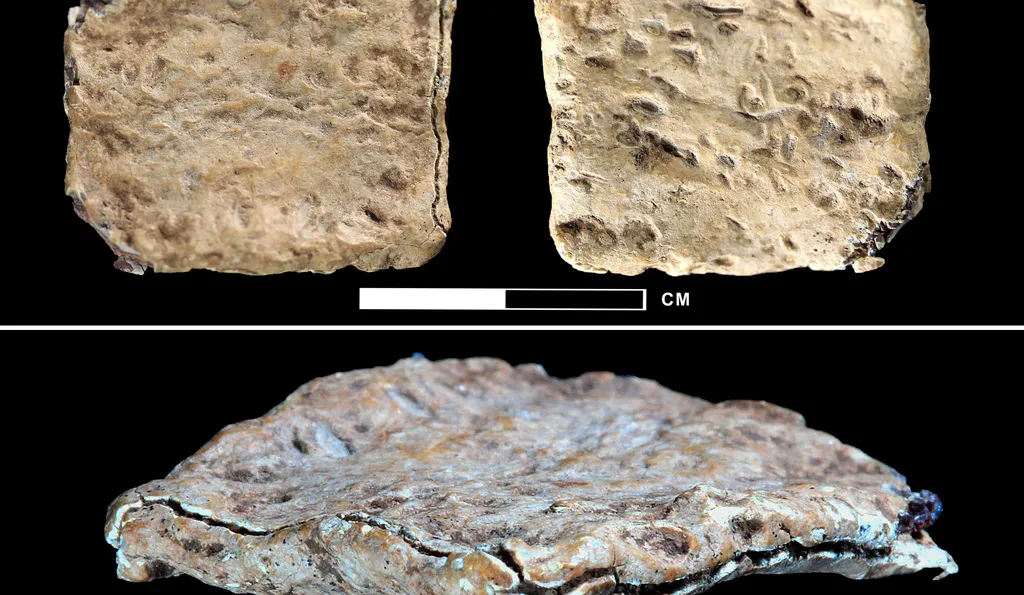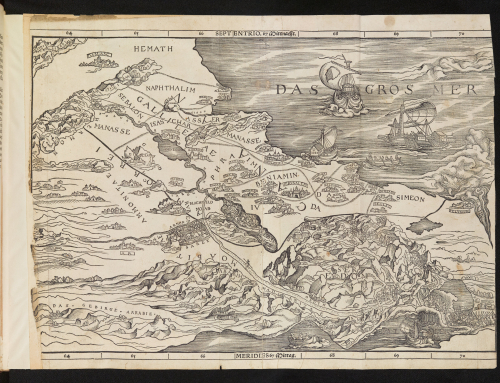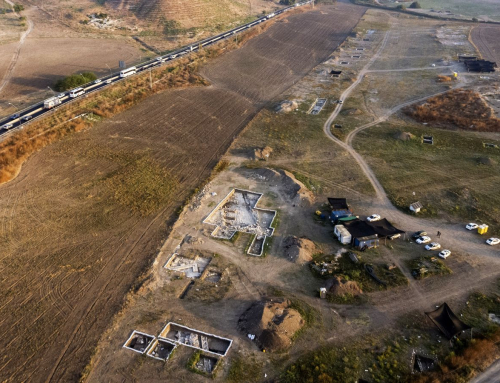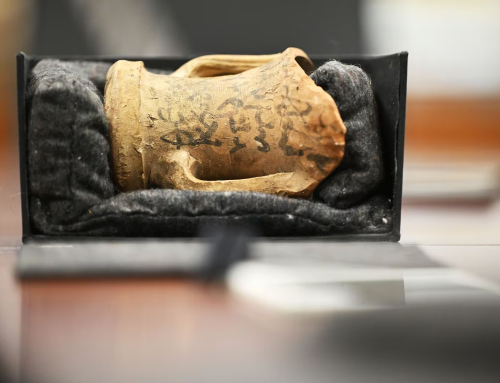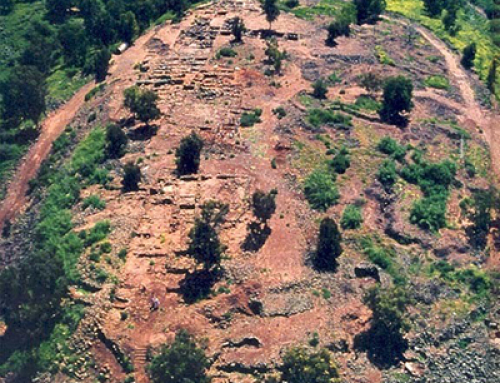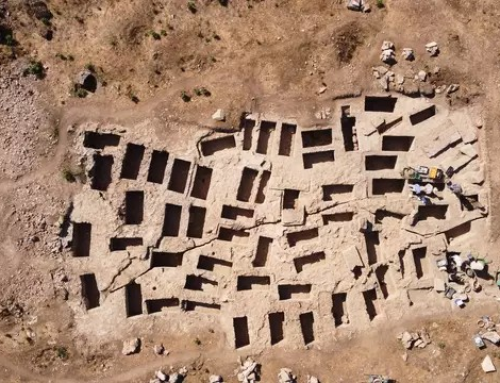Look! It’s a 3,400-year-old inscribed lead tablet that could prove the historicity of the Bible. But actually there is no discernible writing on it and the purported tablet is likely a fishing-net weight commonly used in ancient times.
That’s the short version of the latest chapter in a bizarre archaeological row centered on a minuscule lead artifact and a contested ancient site in the West Bank, believed by some to be the biblical altar built by Joshua on Mt. Ebal.
The long version is a complex story involving a controversial excavation in a volatile conflict zone and sensational claims about what a single find there could tell us about the historicity of the Bible and the birth of the Hebrew language, all on the background of the political and religious strife engendered by the Israeli-Palestinian conflict. Now, an upcoming series of scientific studies is demolishing the initial astounding conclusions by the discoverers of the purported inscription. The studies propose instead that the find is a rather run-of-the-mill artifact and the entire brouhaha was just a biblical tempest in a teapot. But let’s take this one step at a time.
Last year, a team of researchers announced to great fanfare that their excavation of a cultic structure on Mt. Ebal in Samaria – in the northern West Bank – had yielded an extraordinary find: a lead tablet about two centimeters by two centimeters, inscribed with a curse in ancient Hebrew, and dating to the 14th or 13th century B.C.E. That would make this curse the earliest known text in Hebrew by centuries.
The curse had been supposedly written on a lead sheet that was then folded, said the researchers led by Scott Stripling, professor of biblical archaeology and church history at the Bible Seminary in Katy, Texas; Gershon Galil, a retired professor of biblical studies and ancient history at the University of Haifa; and Pieter Gert van der Veen of Johannes Gutenberg-Universitat Mainz.
Since the sandwiched tablet was too fragile to be opened, the researchers used tomographic scans to look inside and claimed to see letters in the proto-Canaanite (or proto-alphabetic) script that they read as follows:
“Cursed, cursed, cursed – cursed by the God YHW.
You will die cursed.
Cursed you will surely die.
Cursed by YHW – cursed, cursed, cursed.”
At the time, the researchers said the language used for the text was Old Hebrew and Galil hailed the find as an “earthquake in biblical studies.” Not only was this the oldest Hebrew inscription by at least two or three centuries; it was key new evidence in the ongoing debate on whether the Bible can be considered a historical document.
The large stone structure on Mt. Ebal, where the purported tablet was found, was first unearthed in the 1980s by Israeli archaeologist Adam Zertal, who interpreted it as an early Israelite altar, possibly even the one built on this mound by Joshua according to the Bible (Joshua 8:30) during his campaign to conquer Canaan.
The curse tablet was dated to the Late Bronze Age, roughly when one would expect Joshua’s conquest to have occurred. Its discovery confirmed that the structure was indeed that very biblical altar, Stripling and colleagues claimed. This was based on the biblical verse (Deuteronomy 11:26, 29) according to which this cultic site was dedicated to just such ritual cursing.
More broadly, the discovery of the tablet suggested that the early Israelites were literate and thus capable of writing the Bible pretty much in real time, the scholars reported. This contradicted decades of research showing that ancient Hebrew writing developed at a later stage and the Bible was written down centuries after most the events it relates, and therefore its accounts cannot be taken at historical face value.
The 2022 announcement of the tablet’s discovery blindsided most biblical experts, who immediately raised a bunch of red flags.
The find was proclaimed at a press conference rather than through a peer-reviewed publication, as is customary for most major scientific discoveries. Since no high-resolution images of the tablet were available, colleagues were unable to tell whether they agreed with the reading of the inscription or even if there were actually any letters there to begin with.
Also, the context of the find was hugely problematic. Stripling and colleagues didn’t unearth the tablet in a fresh dig of neat archaeological layers. Rather, they collected piles of waste from Zertal’s excavation and sifted it at a nearby settlement, which makes it nearly impossible to confirm the date of the artifact.
The dating of the site (not everyone agrees it’s an altar) is already the subject of controversy, since it’s based largely on the pottery finds there, with some researchers placing it in the Late Bronze Age (13th century B.C.E.) and others saying it can only go back to the 11th century B.C.E., in the Early Iron Age.
As for the lead artifact itself, the fact that it was found in the jumbled up dump of Zertal’s excavation meant it was impossible to tell which phase it belonged to, and could have been dropped at the site at any time, including in the Roman era, skeptics noted.
Finally, questions were raised about the dig itself, backed by U.S. evangelical Christians keen on proving the bible right. The excavation was conducted without a permit from the Palestinian Authority, which nominally has civil control over the site, located in Area B of the West Bank, or from the Israeli military, which considered it “private activity.”
Like many archaeological sites in the region, Mt. Ebal is a flashpoint of religious and political conflict. It is frequently visited by settlers and right-wing activists who want Israel to exert sovereignty on this and other heritage sites, which they claim Palestinians are willfully damaging. The Palestinians deny this and assert that Israel has no right to operate in the area under the Oslo Peace Accords and that settlers are using heritage protection as a cover to push for a land grab.
Going back to the tablet, ultimately Stripling and colleagues published an article earlier this year in the journal Heritage Science, making an academic case for their theory and including images of the artifact. But their paper did nothing to quell the academic storm.
In a series of three articles to be published next week in the Israel Exploration Journal a team of researchers examines and refutes the conclusions of Stripling and colleagues, proposing a very different interpretation of the tiny lead artifact.
Stripling and Galil’s claims “are quite dramatic and require close inspection,” says Prof. Aren Maeir, an archaeologist at Bar-Ilan University and one of the lead researchers in the debunking effort.
In the first article, Maeir and renowned biblical epigraphist Prof. Christopher Rollston of George Washington University examine the context of the find, its dating and reading. They run through some of the already-mentioned critical points above and, in analyzing the supposed text of the curse they reach a brutal conclusion: the writing just isn’t there.
The letters drawn by Stripling and colleagues don’t match the bumps and indentations visible in the photos they published, according to the two researchers.
“The photos must correspond with the letters someone believes they are seeing,” Maeir and Rollston write. “In this case, the photos do not correspond with the drawings, and thus, the reading and translation are not anchored to empirical data.”
The lead surface displays “random scratches, striations, pitting, and indentions,” which are consistent with the nature of lead and the processes or erosion and weathering the artifact may have undergone over the centuries, they add.
For the sake of argument, Maeir and Rollston go into a long exposition to show that even if there were letters there (not that they can see any), their reading by Stripling’s team is questionable. For one thing, the letters in the published drawing are arranged in a haphazard “mishmash” or “salad” of letters that follows none of the possible directions that ancient Canaanite script took. The proposed text also contains letters that were not used in Late Bronze or Early Iron Age Canaanite inscriptions and only appear in texts centuries later, meaning that the original reading, if accurate, is quite anachronistic.
Finally, even if the text is there, it is unclear whether it could be defined as Hebrew.
Most of the words, like the oft-repeated ‘arur’ (cursed), were used in other semitic languages spoken in the Levant at the time, Maeir and Rollston note.
The only properly Hebrew word in the text would be the divine name of Yahweh, but even then, it should be noted that the biblical God is also mentioned in non-Hebrew texts.
In fact, Yahweh’s oldest known extrabiblical mention, aside of course from the contested Mt. Ebal tablet, is found in the ninth century B.C.E. Mesha stele, which is in Moabite.
So, according to this study, the lead artifact found at Mt. Ebal is not a tablet at all. But then, what is it?
In the second article of the series, Prof. Amihai Mazar, a retired archaeologist from the Hebrew University in Jerusalem, notes that the artifact has the perfect size, shape and composition to be a “sinker,” an object used to weigh down fishing nets.
In the Late Bronze Age, but also in later periods, these weights were commonly made by folding a thin lead sheet around the netting, which obviously has decomposed with time, leaving archaeologists with these tiny metal sandwiches, Mazar notes.
Hundreds have been found in digs across the Eastern Mediterranean, of different sizes and shapes. The Mt. Ebal one belongs to a subtype that is more commonly found in Greece and less so in the Levant, he writes.
This is also consistent with the isotope analysis of the artifact, which is the topic of the third study in the series and identified the lead as having originated in Greece.
Since some sinkers were decorated with incisions, it is possible that the marks seen on the Ebal artifact are just such an embellishment, though they may also be the result of centuries of the object being smashed and compressed, Mazar notes. In any case, he agrees that no letters are visible, and cites two other eminent epigraphers, Prof. Benjamin Sass of Tel Aviv University and Dr. Anat Mendel-Geberovich of the Hebrew University, as agreeing that no symbols are discernible.
While Mazar acknowledges that most sinkers are found in shipwrecks and at coastal sites, they are not unheard of at sites more inland.
“Of course, one has to ask how and why a fishing-net sinker made of lead from Greece found its way to the inland, mountainous site of Mt. Ebal, where almost no other imported objects except a few Egyptian scarabs and two small Mycenean sherds were found,” Mazar concludes. “This question remains to be answered.”
The last and final study, conducted by Prof. Naama Yahalom-Mack of the Hebrew University, deals with the provenance of the lead in the artifact, which was a key argument by Stripling’s team for dating the object to the Late Bronze Age. While the isotope analysis confirms the metal came from the Lavrion mine in mainland Greece, which is known to have operated in the Late Bronze, this cannot be used to date the artifact as Stripling and colleagues do, because that location was also active in later periods, Yahalom-Mack says.
Stripling responded saying he had not yet read the new studies, but was “confident that there is writing on the tablet and that the script strongly suggests that it dates to the Late Bronze Age.”
The drawings he and his team published in the Heritage Science article “come close to capturing what the tomographic scans revealed,” Stripling stresses in an email to Haaretz.
“It is natural for other scholars to reach divergent views,” he adds. “I have the highest regard for Professor Mazar, but I find it difficult to imagine that lead fishing weights were inscribed with proto-alphabetic letters.”
Galil, the epigraphist in Stripling’s team, did not respond to an e-mail seeking comment as of press time.
But no one is claiming that fishing weights were decorated with letters. The problem is that we might be very well dealing with a case of pareidolia, in which scholars with faith saw patterns that they wanted to see but are not actually there – just like when people see the face of Jesus in the burnt bits of their grilled cheese sandwich.
It is likely that more responses and counterarguments will be made, but it may be time for the theory of the Mt. Ebal “inscription” to go sleep with the fishes.
Original Article – New Studies Debunk Controversial Biblical ‘Curse Tablet’ From Mt. Ebal – Archaeology – Haaretz.com

